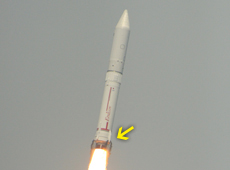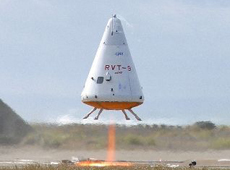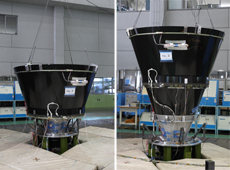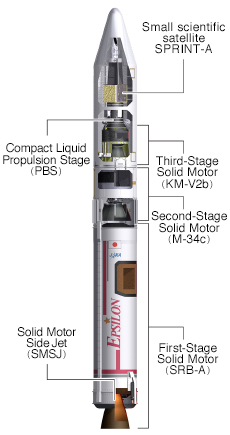
--- Tell us about the new propulsion system that was developed for Epsilon.

Solid Motor Side Jet (SMSJ)
That’s a Solid Motor Side Jet (SMSJ). The SMSJ is an auxiliary propulsion system with a small solid-propellant motor. Two SMSJ systems are attached symmetrically to the bottom of the rocket’s first stage. When you look at a picture of the launch, you will see black smoke being discharged from the SMSJ motors. They are ignited 10 seconds before launch, and keep burning until the separation of the first stage. Their role is to control the rocket’s rotation around its central axis, in order to control its attitude. We do that by selecting the direction of exhaust nozzle of the combustion gas during powered flight. For example, if the rocket is turning clockwise, we vector the thrust of the SMSJ to produce a counterclockwise force.
After the first stage burnout, it takes about 40 seconds for it to separate. During that time, the two SMSJ systems continue to perform three-axis attitude control – that is, controlling roll, pitch and yaw. The SMSJ has jet nozzles placed at perpendicular angles in three different directions. When attitude control is not needed, combustion gas is exhausted equally from opposing nozzles to counteract the thrust of each. And when attitude needs to be controlled, a hot gas valve is opened to discharge more combustion gas from a selected nozzle.
--- The SMSJ was used in the M-V, too. How is this one different?
The M-V had four SMSJ systems for the first stage; the Epsilon has two. So that reduces cost. We doubled the thrust by making the SMSJ motorlarger. By increasing the diameter of the solid-propellant motor and decreasing the speed of the propellant burning rate, we augmented the thrust, and increased the operating time from about 75 seconds on the M-V to almost three minutes. That gives us sufficient time to control the rocket’s roll, pitch and yaw during the first stage flight. Also, to achieve three-axis attitude control with two SMSJ systems, we enable them to exhaust combustion gas in three directions rather than two. We managed to get very high-performance attitude control from Epsilon’s SMSJ. But at the start, I wasn’t sure we really could make it. This was one of the most challenging part of the project.
--- Does the Epsilon rocket use the same fuel as the M-V?
The fuel is basically the same as before, but we changed the composition to decrease the propellant burning rate and extend the burn duration. The challenge was to achieve long, stable combustion for as long as three minutes, and we did it.
On top of the third stage of Epsilon-1 is the Post Boost Stage (PBS), which has a small liquid-fuel engine to enhance the accuracy of orbit insertion. The liquid-fuel tank is filled and sealed at the factory, and then carried to the launch site. We changed the design of the tank in accordance with public-safety regulations, so that it can be transported from the factory to the launch site. Traditionally, fuel tanks are filled at the launch site, but this change has reduced the labor required, which is a further cost reduction.
--- What is the advantage of solid-fuel rockets?

Reusable launch vehicle being studied by JAXA
It’s their simple structure and simplified operation. To put it simply, solid-fuel rockets have a very simple structure – like skyrocket. Once they are ignited, we can’t cut off them actively, so they are not suitable if you need to vary the thrust magnitude during flight. However, we can use ground tests to accurately determine how the fuel burns and how many seconds it takes to generate a certain amount of thrust. So as long as we operate a solid-fuel rocket based on that data, it is possible to insert a satellite into orbit with a certain level of accuracy. Also, because solid fuel is safe to move after the rocket is filled at the factory, you don’t need a fueling facility at the launch site, so that simplifies the preparation to launch.
--- How long have you been working on solid-fuel launch vehicles?
I started making solid-fuel rockets in my first year of university. I started working on liquid-fuel rocket research only much later, in 1998. My ongoing research is on a cone-shaped reusable launch vehicle that takes off and lands vertically. I was a member of that research team for 11 years, until full-scale development of Epsilon started in 2010. I’m also working on the engines for a reusable sounding rocket, and we are making steady progress.
--- What lessons did you learn from the launch of Epsilon-1?
I was very disappointed by the second postponement of the launch – I mean, by my own role in it. The postponement was caused by a misalignment by 0.07 seconds in the data transmission between the on-board computer on the rocket and the launch control system on the ground. When I was working at the Uchinoura Space Center, I noticed the delay in the timer on the rocket, which would start with a command from the ground launch control unit. However, everybody was busy with pre-launch checkout, so I was hesitant to add more issues for them to look at, and I didn’t express my concern.
The reason the time delay caught my attention was that I had experience working on an automatic launch system in an experiment with the reusable rocket. For that experiment, I had to perfectly synchronize the timer of the launch control system, which was programed with the operation sequence of the liquid-propellant rocket engine, and the timer of the rocket’s on-board computer. I regret that I didn’t bring up my concern. I’ve decided that anytime I notice something in the future, I will speak up.
--- How will the next Epsilon be different?

Extension test of second-stage motor nozzle of Epsilon
We aim to further reduce the cost of launch by making a small, light high-performance rocket. The original concept for Epsilon is a small rocket that’s simple to operate. Propulsion systems account for a third of a rocket’s cost, so cost reduction is a crucial issue for our team. To save money, we need to try something new, yet retain the original level of performance. This is a challenge. The first Epsilon rocket used existing technologies, but we are hoping that by 2017 we can replace all the propulsion systems with more cutting-edge technologies. Well… I feel I am talking only about saving money… but, deep down, I want to think about how we can make an interesting rocket, too.
--- What’s the attraction of rocketry for you?
Simply put, novel ideas. I mean ideas that astonish people and are unique to Japan. You cannot compete in the world unless you make a more attractive rocket than other countries. For instance, Epsilon’s second- and third-stage motors use the unique extension nozzle inherited from the M-V. That nozzle is folded and stored until the previous stage separates from the rocket. It then allows combustion gas to be exhausted at higher speeds, producing more thrust. Also, because the nozzle is retractable for storage, the rocket can be shorter, which can reduce the manufacturing cost of the interstage structures. This novel technology was originally created for the M-3SII rocket, the one before the M-V. I’d like to come up with more unique solutions like this one.
--- When do you think of your ideas?
When I’m facing a challenge and concentrating on finding a solution. But it’s not like I just sit at my desk. When I am working hard on a problem, a new idea may come to me when I’m taking a walk or having a bath.
--- What is your dream rocket?

It’s a reusable launch vehicle that can operate like a passenger aircraft. For rockets to be able to take off and landing as frequently as airplanes, they have to be light and small; otherwise they won’t be able to transport things efficiently. Of course drastic cost reduction is an important issue, and such a rocket must inevitably have an automatic and autonomous checking system. So that matches up with the concept of Epsilon, and I think the technologies developed for Epsilon can be applied to a reusable launch vehicle. Actually, the reason I am working on Epsilon is precisely that I want to create a reusable rocket. I am hoping that I can showcase it within the next 10 years.
--- Does “reusable” mean that you will eventually aim to make a manned launch vehicle?
I don’t know if JAXA will initiate such a project, but personally I think rockets are uninteresting unless people can get on board. Opportunities will be greater when we really start sending people to space rather than just payloads. I think that if many people start making frequent trips to space, different types of enterprises will blossom there.
--- I hope that you will have a chance to go to space on one of your own reusable launch vehicles.
I would love to. When I read about Yuri Gagarin as a child, I thought that he was very cool. I recall that it was then that I aspired to go to space for the first time. The aspiration was almost gone by puberty, but when I started preparing for the college entrance exam and thought about what to study, I decided I wanted to have a job related to space. I was a little odd, so I wanted to try something different from others (laugh).
--- Finally, what is your vision for the future?
I want to build rockets that can be launched daily. Before we get there, there are many challenges to overcome, regarding engine performance and the structure of the rocket, for example. But I do believe that technological problems can be solved as long as we keep working hard towards that goal. So I am not going to give up on my dream.
Associate Professor, Department of Space Flight Systems, Institute of Space and Astronautical Science (ISAS)/JAXA
Dr. Tokudome earned his doctorate from the Department of Aeronautics and Astronautics at the University of Tokyo in 1995. In the same year, he joined the Institute of Space and Astronautical Science (now part of JAXA) as a research assistant at the Kagoshima Space Center, and has been dedicated to the development of propulsion systems for the M-V launch vehicles and a reusable rocket. Since 2010, he has also been a member of the Epsilon Launch Vehicle Project team at the Space Transportation Mission Directorate of JAXA, responsible for propulsion systems. He specializes in space propulsion engineering.
Making good rockets requires more simplicity!
Epsilon Technology: A Link to the Future
Epsilon: A Soft and Comfortable Ride
The Anytime, Anywhere Rocket
Building a Versatile Rocket

